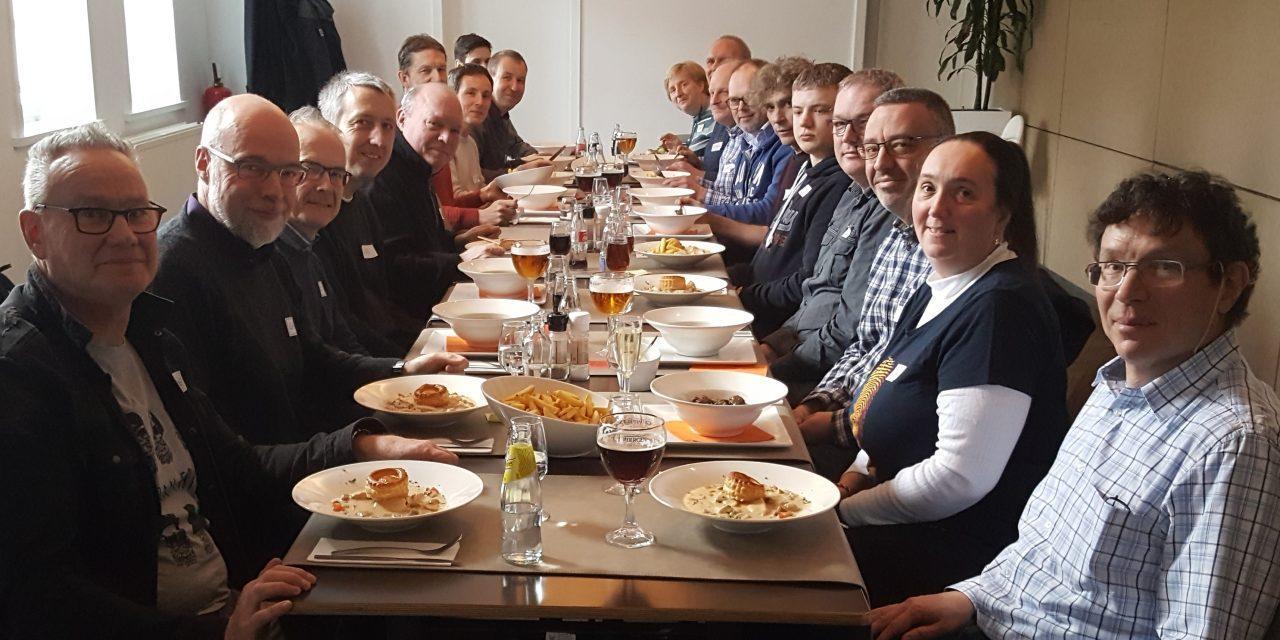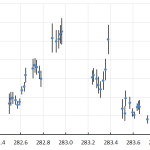A summary of the activity of the CAMS BeNeLux network during the month of March 2019 is presented. 1217 orbits were collected during 29 nights with a maximum of 78 operational cameras at 20 different CAMS stations. The annual CAMS meeting took place on 10 March at the Observatory Mira in Grimbergen, Belgium.
1 Introduction
Past few years March had the typical weather pattern for this month without many favorable nights for astronomical observations. Meanwhile it is several years ago that March brought exceptional good weather but then the CAMS BeNeLux network had considerably less cameras available. Would March 2019 be better than what we got in March during previous years?
2 March 2019 statistics
The weather followed a similar pattern as previous year during this month with rather unfavorable weather. The first half of the month was very poor while only few clear nights occurred in the second part of the month. Only 5 nights had more than 100 orbits and only two nights remained without any orbit.
Table 1 – March 2019 compared to previous months of March.
| Year | Nights | Orbits | Stations | Max. Cams | Min. Cams | Mean Cams |
| 2012 | 2 | 12 | 2 | 2 | 2.0 | |
| 2013 | 10 | 69 | 6 | 7 | 4.2 | |
| 2014 | 24 | 793 | 12 | 29 | 22.8 | |
| 2015 | 23 | 1033 | 14 | 42 | 31.7 | |
| 2016 | 23 | 856 | 16 | 51 | 12 | 38.2 |
| 2017 | 26 | 1048 | 19 | 55 | 20 | 44.4 |
| 2018 | 25 | 1280 | 22 | 91 | 53 | 73.5 |
| 2019 | 29 | 1217 | 20 | 78 | 54 | 64.4 |
| Total | 162 | 6308 |
CAMS BeNeLux captured 3540 multi-station detections that resulted in 1217 orbits. March 2018 had more (1280) orbits with less detections (3391) although March 2019 counted 29 nights with orbits against March 2018 with 25 nights with orbits. At best 78 cameras were active, a minimum of 54 cameras capturing each night with an average of 64.4 operational cameras per night at 20 stations. In March 2018 we had as many as 91 cameras at best with an average of 73.5 each night at 22 stations. Reason for the decline in camera capacity is the loss of the strategic important CAMS station at Ooltgenplaat, the Netherlands that had 8 cameras and the CAMS station Terschelling with 4 cameras where the CAMS PC crashed months ago.
In total CAMS BeNeLux collected 6308 orbits during 162 March nights accumulated during the past 8 years. The statistics for March 2019 are compared in Table 1 with all previous months of March since the start of the CAMS BeNeLux network.

Figure 1 – Comparing March 2019 to previous months of March in the CAMS BeNeLux history. The blue bars represent the number of orbits, the red bars the maximum number of cameras running in a single night and the yellow bars the average number of cameras running per night.
3 CAMS meeting 10 March 2019
Since 2013 the CAMS BeNeLux participants come together to meet in person to discuss technical issues, results and future plans. The 2019 meeting was planned at the Public Observatory Mira in Grimbergen, Belgium.
The CAMS BeNeLux network coordinator Carl Johannink welcomed everybody and presented the program for the day with some short announcements about CAMS.

Figure 2 – CAMS meeting March 10 at the Observatory Mira, Grimbergen, Belgium. At left from front to back: Jean-Marie Biets, Carl Johannink, Luc Gobin, Uwe Glässner, Robert Haas, Jos Nijland, Tioga Gulon, Peter Pelgrims, Jan Pelgrims. At right from front to back: Paul Roggemans, Adriana Roggemans, Hervé Lamy, Steve Rau, Ian Rau, Tim Polfliet, Marco van der Weide, Martin Breukers, Erwin van Ballegoij and Ann Schroyens.
After this introduction each CAMS station operator shortly described the situation, technical problems encountered and future plans at each CAMS station. The advantage of this open discussion is that problems at one station are often quickly solved thanks to the solutions applied at other stations. Since the rapid expansion of the network in 2017, several technical issues often prevent some stations to fully participate.
Hervé Lamy gave a talk about BRAMS, the network for radio meteor observations. The first attempts were done to match radio echo results obtained by BRAMS with the video data obtained by CAMS. Contrary to radar work, single station radio observations don’t tell us anything about the radiant or exact position of meteor trajectories. Too many variables remain unknown for the complex ionization process, while most of these variables are known from the CAMS data. The meteor radio echoes of BRAMS and the video meteors captured by CAMS share a large part of the atmosphere above the BeNeLux. This allows to study statistically significant samples of CAMS trajectories that match with BRAMS radio echoes.
Paul Roggemans presented the method used to find meteor orbit concentrations and how meteor shower characteristics can be derived from large numbers of meteor orbits. Orbits are the best way to do meteor shower identifications, avoiding the controversy that is often raised with single station data where the shower identification is based on assumptions only. To understand the necessity to work with orbit data instead of single station data, the complex nature of the evolution of dust streams in the solar system was explained.
A lunch had been reserved at the local restaurant Fenikshof in the Monastery of Grimbergen, origin of the famous Belgian beer with the same name. After the lunch the results of different case studies on meteor showers based on orbital data were presented.
Jean-Marie Biets presented some results of a recent fireball event over Belgium on 15 February 2019. An overview of all the images was presented together with the results obtained by CAMS and by the all-sky data reduced by Pavel Spurny.
Another typical topic at CAMS meetings are the pointing directions of the individual cameras. If enough cameras are available, the atmosphere can be guarded from different sites in a way that even partial cloud cover cannot prevent that many meteors are being recorded from at least two stations. The many small FoV cameras are pointed in such a way that optimal coverage of the atmosphere is achieved from different sites. Viewed in Google Earth this looks like colorful puzzle of intersecting camera fields.
The new RMS cameras were shortly discussed. The first of these cameras were installed to test and such a RMS camera was brought to the meeting to show how it looks like. The current CAMS network is equipped with Watec H2 Ultimate cameras with Pentax 1.2/12mm lenses, EzCap dongles are used as framegrabbers. It is getting difficult to purchase this hardware which is all more than 10-year-old technology. The CAMS BeNeLux network risks to run out of spare parts. The RMS cameras developed by the Croatian ISTRA Stream can serve as a good alternative for future purchases of cameras. The results of these RMS cameras are 100% compatible with our CAMS standards, while for the small field optics of the RMS, the resolution is much better with 1.8 arc/pixel against 2.8 arc/pixel for our Watecs. The calibration is done for each detection which improves the positional accuracy. First tests with these cameras result in a much better score in number of orbits than with any of the old Watecs.
The final talk was given by Steve Rau who discussed the most frequent technical problems reported by the CAMS camera operators. An overview was given of all bugs that were solved in 2018 and a number of technical advices were given.
Before the CAMS meeting was closed by Carl Johannink, a present was offered to Steve Rau for his technical support to the CAMS stations, distribution of the CAMS software and installation of AutoCAMS. The AutoCAMS provided by Steve Rau is to a large extend responsible for the impressive number of orbits collected by the network. Finally, Carl Johannink and Martin Breukers both got a bottle of wine offered to thank them for their continues efforts to collect and to reduce the CAMS data on a very regular bases, preventing delays in data reduction.
After the official CAMS meeting which ended a bit sooner than foreseen, a number of participants stayed few hours longer in Grimbergen to have a drink in a local pub and a dinner in a local Chinese restaurant.
4 Conclusion
March in general is a rather poor month for astronomical work and March 2019 was no exception. Although that the number of operational cameras decreased compared to last year still a very nice result could be obtained.
Acknowledgment
Many thanks to all participants in the CAMS BeNeLux network for their dedicated efforts. The data on which this report is based has been taken from the CAMS website (http://cams.seti.org/FDL/index-BeNeLux.html). The CAMS BeNeLux team is operated by the following volunteers:
Hans Betlem (Leiden, Netherlands, CAMS 371, 372 and 373), Jean-Marie Biets (Wilderen, Belgium, CAMS 380, 381 and 382), Martin Breukers (Hengelo, Netherlands, CAMS 320, 321, 322, 323, 324, 325, 326 and 327, RMS 328 and 329), Bart Dessoy (Zoersel, Belgium, CAMS 397, 398, 804, 805, 806 and 888), Jean-Paul Dumoulin and Christian Walin (Grapfontaine, Belgium, CAMS 814 and 815), Luc Gobin (Mechelen, Belgium, CAMS 390, 391, 807 and 808), Tioga Gulon (Nancy, France, CAMS 3900), Robert Haas (Alphen aan de Rijn, Netherlands, CAMS 3360, 3361, 3362, 3363, 3364, 3365, 3366 and 3367), Robert Haas (Texel, Netherlands, CAMS 810, 811, 812 and 813), Robert Haas / Edwin van Dijk (Burlage, Germany, CAMS 801, 802, 821 and 822), Klaas Jobse (Oostkapelle, Netherlands, CAMS 3030, 3031, 3032, 3033, 3034, 3037, 3038 and 3039) , Carl Johannink (Gronau, Germany, CAMS 311, 312, 313, 314, 315, 316, 317 and 318), Hervé Lamy (Dourbes, Belgium, CAMS 395), Hervé Lamy (Humain Belgium,, CAMS 816), Hervé Lamy (Ukkel, Belgium, CAMS 393), Koen Miskotte (Ermelo, Netherlands, CAMS 351, 352, 353 and 354), Tim Polfliet (Gent, Belgium, CAMS 396), Steve Rau (Zillebeke, Belgium, CAMS 3850 and 3852), Paul and Adriana Roggemans (Mechelen, Belgium, CAMS 383, 384, 388, 389, 399 and 809, RMS 003830), Hans Schremmer (Niederkruechten, Germany, CAMS 803) and Erwin van Ballegoij (Heesch, Netherlands,CAMS 347 and 348).



